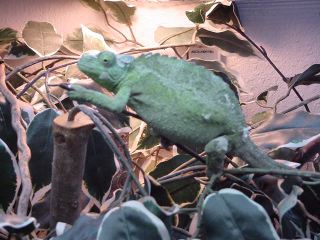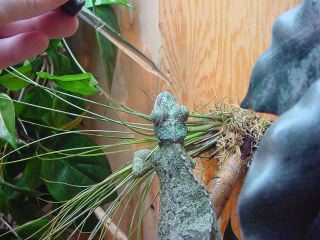Keeping Jacksons Chameleons

Specific Information concerning the Chameleon known as:
Jackson’s Chameleon (Chamaeleo jacksonii xantholophus)
Specifically ; Hawaiian species. (1972).Ventura.

This species of lizard is highly adapted to living in trees and bushes
and has opposable toes on all four feet specifically designed for this
arboreal lifestyle.
Before 1972 all Jackson’s Chameleons were imported from the slopes
of Mt. Kenya in Eastern Africa. In Eastern Africa, the
Jackson's Chameleon is found between 6000-8500’ ft elevations.
There are currently three (3) known subspecies of the Jackson’s
Chameleon available on the pet market.
We will be discussing the subspecies available in the United States.
This species is imported from Oahu on the Hawaiian islands.
Almost all of the Jackson's Chameleons available to the U.S. hobbyist
are now collected there.
They are now rarely imported from East Africa.
I will discuss several steps to proper maintenance, including housing
and captivity in Alaska,
Description:
Jackson's Chameleon is sexually dimorphic,
Male Jackson's Chameleons have up to three horn like projections
that extend from the front of the nose.
Females typically do not have these horns although a few may have
small stubs. They are think bodied lizards that on average measure
from 4.5” to more than 12” in males. Neonates (Juveniles)
are generally between 1.2 and 2.5” when born.
Captive propagation in the U.S. has been recorded.
This reptile has very specialized arboreal adaptations that easy
distinguish it from other lizards available to the U.S. hobbyist.

Captive Care:
In this section I will discuss the “herpetoculturial” care aspects
including those special needs for Alaska.
Jackson’s Chameleons DO require very specialized care!
Jackson's will do poorly and die if not offered this exacting care in
captivity. They need to be housed individually. In warm states it is
best to house them in large open air (outdoor) aviaries,
such as those used for small song birds.
In cold states such as here in Alaska, they can be housed in
custom built wire/wood enclosures and kept indoors.
An effort should be made to provide a “summer” cage so that they
receive some of our long Alaskan summer sunlight.
Which in my area lasts 24 hours from June till early August.

Lighting:
Jackson's Chameleons have specific lighting requirements.
They must have lighting that produces both U.V.a and U.V.b in the
wavelength of 5500k. Several lights on the market today provide
this needed ultraviolet radiation.
Included in the list are the Vita-lite from Durotest, the Croma 50
from G.E. Corp., the Iguana 5.0 from Zoo-Med laboratories among
others.
Most if not all of these lights are available at pet shops that sell reptiles.
The Croma 50, by G.E. Corp,. Is generally available at large stores
such as Fred Meyer or Kmart.
These lights are only effective from 12” above the animal being
kept and loose all effective U.V. within 1 year and must be replaced.
I recommend that a 2-bulb 48” shop type fixture be utilized with
a timer. So, a typical lighting set up for Jackson's Chameleon would
be 1-48” 2 U.V a/b bulb set up, that includes a timer set for 12-14
hours of daylight. The light should never be left “on” all of the time.
Chameleons require “night” as well as “day” for proper metabolic
functions. In Alaska, we have long days in summer which offer the
keeper of Chameleons the opportunity to allow chameleons ample
exposure to U.V. radiation. An attempt should be made to allow
captive “Alaskan” chameleons exposure to natural sunlight as long as
temperatures remain at or about 75f. Some keepers have two cages
for chameleons or one cage that can be rolled into the sun light for
summer time exposure. Remember that direct exposure can lead to
over heating and death, so use caution.
generally, avoid rolling your chameleon cage into direct “noon” time
sunlight.

Spot-lamps and Temperatures:
A “spot” type lamp must be added to proved a basking area of at
least 85-90f.
This may be a simple clip-on style lamp with a 60 to 100 watt
incandescent bulb. This “hot” spot in the enclosure should be in
one spot and allow the lizard to move in and out of this area as
needed to regulate body temperatures.
In winter, or in Alaska, you may want to install a second spot lamp
or increase the wattage of the bulb(s) so that the “hot” spot
temperature remains at 85-90f.
Tropical reptiles do not need to have a drastic reduction in
temperature for burmation. (hibernation)
If needed, and I am not usre that it is, you can lower the “daytime”
temperatures by a few degrees over the period of
November/December, allowiing naturally lower nighttime
temperatures to help you.
Daytime cage air temperatures can range from the low to mid 80’s
and extend to the low 90’s in summer and may drop to the mid
to upper 70’s in winter and at night.
Obviuosly, it will remain hotter under the spot lamps.
In Alaska, it is important to remember that as the temperature
drops below zero outside, and we start to rely on heaters and
fireplaces to heat our homes, it becomes vital that chameleons are
not exposed to temperatures below 60f.
So pay the oil bill!!

Housing:
I have found that Jackson's Chameleons do well if given at least
a 3’X3” by 4’ tall enclosure.
These are generally custom made, but several specific “Chameleon”
cages are available on the pet market.
One such brand is called the “Reptarium”.
The enclosure should be made party of screen or wire mesh for
ventilation. Jackson's Chameleon will do poorly if kept in “fish” tanks
with stale air.

Cage furniture:
Chameleons are arboreal and thus require climbing branches,
small trees, either fake or real and foliage to hide amongst.
A simple bamboo dowel with a small ficus (Fig) tree can suffice.
Chameleons rarely walk onto the ground except to dig a nest and lay
eggs**, Any Jackson's Chameleon encountered walking on the
substrate in a pet shop should be avoided as it is likely to be sick.
* *It should be also noted that the Jackson's Chameleon is a live-
brearing species, and do not dig a nest or lay eggs.
Substrate:
Is not important unless you plan to captivity breed and then a
substrate of wood bark or fine sand might be used for the egg laying
species.
Jackson's Chameleons do not walk about on the floor as some other
species may do, so flooring “substrata” is purely up to the decorator
of the enclosure might be used to plant live plants into for
decoration.
Humidity:
Jackson's Chameleons require humidity levels to be approximate
of that found in the jungle canopy from where they originate.
Alaska has very little humidity and the use of a mist bottle or
humidifier may be helpful to provide the moisture required by
chameleons.
In both East Africa and the U.S. Hawaiian Islands,
humidity levels average between 70 and 100%, due to moisture
from constant rains.
Constant low humidity levels will cause a Jackson's Chameleon
to do poorly and may cause death.
Humidity relates specifically to water to Chameleons!!
Drinking:
Chameleons do NOT drink water from a bowl like the family dog.
They will not drink from any water source including those with
air-stones powered by fish tank pumps.
Fancy water falls or fountains such as the many available at
department stores may or may not work and should not be trusted.
Water must be free moving and in droplet-“rain” form.
Although this may seem an impossible task to duplicate in captivity
it is actually fairly easy if monitored and aided by the use of a
small eye dropper or biological pipette available at any drug or
department store.

Drippers:
The use of a 1 gallon plastic mayonnaise or pickle jar with a
small hole drilled into it with a small valve and air tubing will
create a great “dripper”.

Drippers made simple;
Simply drill a hole, small enough for a small plastic on-off valve
available at any pet shop or hardware store,
silicone it into place and add a few feet of fish tank airline
tubing directed over a few branches, in the enclosure and your
chameleon will see the movement of the droplets of water and will
drink from this waterer.
Be sure to have a “catch-bowl” located under the dripper to collect
the water as it drips, otherwise you will have a small flood to clean up.
To be sure your chameleon is drinking,
I also recommend that you use a small (new and clean)
Eye- dropper filled with luke warm water and drip it onto the
nose of your Chameleon at least once a week.
It is thought that some water may be absorbed through the skin
and gentle misting with soft bottled water may aid in providing
humidity and added moisture.
During dry Alaskan winters a gentle misting in the morning may
be helpful for chameleons and aid in shedding.

Dehydration:
Dehydration is very likely one of the major causes of death
in captive Jackson’s Chameleons.
Simply stated , the Chameleon does not see moving water
and then does not drink, they become dehydrated and seem
to be unbalanced so they move to the floor of the enclosure
so that they do not fall over.
Once this occurs it is vital that they receive water that contains
electrolytes within 5 to 10 hours or they will die.
Adding misting to your daily chameleon tasks may actually aid
in knowing that your chameleon is receiving water.
Chameleon care does not involve placing the chameleon into
a cage and assuming that it will eat and drink.
It’s not gonna happen...
If you need to boost a chameleon that is dehydrated;
Electrolytes are common in Orange juice and Gatorade brand drinks.
These may be given as fluid (water)replacements.
Professional Veterinarians may also use more advanced glucose or
caloric replacements.
generally having a good “herp’ vet will sure help.
:O)
Administration of fluids:
Chameleons like other reptiles and like birds have a wind pipe
located in the mid portion of the mouth cavity.
It is vital that water NEVER be forced into the mouth
but rather dripped at the nose or slightly placed into the front
“lip” area.
The tube feeding methods used to force feed/water reptiles and
baby birds are very dangerous if not administered properly
by a trained professional.
So when in doubt, don’t try this at home..kids...
Individuals with proper tools and knowledge often times use
the tube method to force a small amount of needed food or liquids
down the throat of sick animals, this is common practice and has
varying results.
This practice should only be administered by a person with
advanced knowledge of the subject.
Asphyxiation is a common occurrence from forcing water or any
object into the mid-to rear area of the mouth.


Vitamins:
Chameleons require both vitamins and trace element supplementation
to excel in a captive environment.

Several top-notch products are available to anyone through
local pet stores and any online catalog seller of “Reptile” products.
Try any of the following:
Miner-all (D3) or Rep-Cal(D3) supplements for Vitamin D3, this is
Calcium. Also a fantaastic product is Liquid Solar-Drops.
Calcium should be sprinkled into a small cup and the insects
that are to be fed to the lizard should be placed into this cup
so that they can be gently coated with the vitamins.
(by shaking the cup).
Calcium and Vitamin D3 are naturally produced by the body
under normal UV lighting from the sun.
It works something like this;
the reptiles body produces D3 by receiving UV radiation from
natural sunlight which helps produce proper white blood cell counts. and make strong bones..
Got milk?
Without D3 added to the diet, the common effects are
rubbery looking jaws, that do not close properly
(this can also be a sign of mount rot)
(see your vet)
bowed-leggs and softening of the bones. {Rickets}
Light or lack of natural light can be a very distressing
problem in Alaska.
It is a known fact that seasonal affective disorder {S.A.D.}
is common in Alaska and is partly caused by lack of useable
U.V. radiation in our long dark winters.
It is linked to sucucide and heavy drinking..
(in humans..)
So, make sure that Chameleons are exposed to daily U.V. radiation.
It’s good for people too.
Electrolytes;
Are generally included in the stomach contents of prey items
consumed by reptiles and amphibians in the wild.
It is a common assumption that the deadly Poison-dart frogs
from South America loose the Alkolyte poisons in captivity
because they lack a trace element in captivity feed insects,
like domesticly fed/reared crickets and fruit flies.
In Chameleons, these trace elements may be used to help
the specialized pigmentation of the skin which helps the chameleon
to change colors, and evade predators.
It may also serve metabolic brain functions as well.
Commonly used trace element products are found at stores that carry
products for birds. Generally supplements that contain Beta-3
Carotene. A commonly available brand is Nekton-Beta “R”.
These tend to cause the skin to be more vibrant and colorful.
This can be something like giving a dog oils for a healthy coat.
Similarly, in Iguanas that eat fruits, Red and Yellow colored items
may contain these trace elements also.

If you must handle a chameleon:
Always allow chameleons to climb onto you, never pick them up.
Here a male Veiled Chameleon has climbed onto the back of the
author.
This chameleon was allowed to walk off my back and back into
it’s encloure.
I did not touch it, and I recommend that they not be handled.
Feeding:
Jackson's Chameleons eat a variety of small insects,
lizards and hatchling birds in the wild.
In captivity Jackson's Chameleons will thrive on a diet consisting
of the standard commercial insects.
Diets consist commonly of;
Crickets, Cockroaches, Mealworms, Waxworms.
They may also consume newborn pink mice.
These food items should be coated with vitamins at least twice
weekly, as described earlier in this care sheet.
Commercially raised Crickets

Crickets may be purchased from local pet shops for .10˘
or so each, or purchased from mail order bait dealers for about
$15.00 per thousand by weight.
Be sure to feed the crickets a good quality chicken food or fruits
and vegetables and remember your chameleon IS what it
EATS.
Meal worms.

Meal worms are the larval stage of a beetle.
they are of “some” value as a food item especially if fed
quality food so that they are gut loaded with vitamins and trace
elements.
They can be easily cultured with wheat and apple slices.
WaxWroms

Waxworms are the larval stage of the wax moth,
a common pest of bee hives.
They are sometimes called honey moths.
Wax worms are very fattening and are used to put weight on
reptiles and are a “treat” food item.
Handling:
No Chameleon likes to be handled.
Handling will dramatically reduce it’s life span.
Males seem to be more tolerant of handling than do females.
If you must handle a chameleon, be sure to never tear it off
of the branch that it is holding on to and be sure to never
restrain it but offer it an open hand to perch on as it would any stick or branch.
The best way is to allow the Chameleon to naturally climb onto
you as it would and branch.
Be sure when returning the chameleon to it’s enclosure that
you place a hand under it and help support it as it reaches out
towards the branches.
Also, keep in mind that the chameleons tail is non-removable
as it is in some other lizards and that the chameleon uses it as a
fifth leg.
The Prehensile tail of a Chameleon.

Never pull on the tail of a chameleon as it is used as a
leg and if it becomes injured, the chameleon may not be
able to climb and steady itself on the branches in which
it lives.

The specialized foot of a Chameleon.
More on Handling:
Remember that the feet of Chameleons are specifically designed
for an arboreal lifestyle.
The chameleons feet are not designed for walking on ground substrate.
Never “pull” a chameleon from a branch, instead allow it to walk
onto your hand or use a small branch to coax it where you want it.
It is better to NOT attempt to handle Chameleons.
They are not “pet” type lizards that like handling and human contact.
There are many lizards that respond well to human handling.
TRY:
Bearded Dragons, Uromastyx and Iguana’s as these seem to “tame”
and not mind being handled.
Sources of further Reading:
There are several great books and magazines available to the hobbyist
wanting to keep chameleons. Online sources include:
The chameleon information network at:
C.I.N.
and my modest wesite at:
Herpetoculture
Magazines such as “Reptiles” is available online and by subscription
and local bookstores and pet shops stock it.
Sources for this Caresheet:
The two main information guides with relation to
Jackson Chameleons,
that I used as source materials are:
de Vosjoli, Philippe & Ferguson, Gary. 1995
Advance Vivarium Systems.
Care and breeding of Chameleons.
McKeown, Sean, 1996.
Diamond head Publishing, inc.
A field Guide to the Reptiles and Amphibians
in the Hawaiian Islands.
Other Quality Chameleon Guides:


My three “favorite” chameleon guides.
back





















